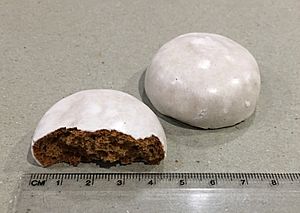Pfeffernüsse facts for kids

Pfeffernüsse, by Aldi
|
|
| Alternative names | Peppernuts |
|---|---|
| Type | Cookie |
| Place of origin | Denmark, Germany, Netherlands |
| Main ingredients | cardamom, nutmeg, cinnamon, cloves, ginger, black pepper, mace, anise, sugar, butter, eggs, flour |
Pfeffernüsse are small, spicy cookies that many people enjoy, especially during holidays. They are very popular in Germany and among Mennonite communities in North America. You can also find similar cookies in Denmark and the Netherlands.
The name Pfeffernüsse means "peppernuts" in German. In Dutch, they are called pepernoten, and in Danish, they are pebernødder. Even though they are called "nuts," these cookies do not actually contain nuts. They are just shaped like small nuts, making them easy to eat by the handful!
Contents
History of Pfeffernüsse
The first recipe for Pfeffernüsse was created in 1753 by Johann Fleischmann. He was a baker from Offenbach am Main, a town in Germany.
Famous people loved these cookies! The writer Johann Wolfgang von Goethe praised them. The composer Felix Mendelssohn even traveled to Offenbach just to buy them. The German state of Hesse has served these cookies at special events for important guests.
In 1820, the famous Brothers Grimm, who collected fairy tales, wrote to their sister. They told her not to eat too many "pepper nuts" because they might make her feel too warm!
In Germany, Pfeffernüsse are a traditional treat for Christmas. People have been enjoying these cookies during holiday celebrations since the 1850s. The name "peppernuts" comes from the small amount of pepper added to the dough before baking.
Ingredients for Pfeffernüsse
Even though recipes for Pfeffernüsse can be a bit different, they all use many fragrant spices. The most common spices are cardamom, nutmeg, cinnamon, cloves, ginger, black pepper, mace, and anise.
To make the cookies sweet, bakers use molasses, sugar, and honey. Some types of Pfeffernüsse are dusted with powdered sugar, but this is not how they were traditionally made. The dough for these cookies usually includes butter, shortening, or margarine, along with eggs and flour.
Special ingredients called leavening agents are added to the dough. These include baking powder, baking soda, potassium carbonate, or ammonium carbonate. They help the sticky dough become light and airy when baked. The dough is then mixed by hand or with an electric mixer.
German Pfeffernüsse Varieties
Pfeffernüsse cookies can look and taste a bit different depending on where you are in Germany.
- In northern Germany, Pfeffernüsse are small, round, and firm. They are about two centimeters wide.
- The "Moppen" version from the north is larger and softer. It's made from a dough similar to gingerbread and often has a sweet icing on top.
- In southern Germany, the dough might include candied lemon or orange peel. They also often add orange zest, lemon zest, and sometimes almonds.
- In Saxony, a region in Germany, the cookies are about three centimeters big. They are not coated and have an angular shape.
- Some German Mennonite families have recipes that use peppermint extract instead of traditional spices. These cookies have a light minty flavor, are soft, and are covered in powdered sugar.
Dutch Pfeffernüsse Varieties
In the Netherlands, there are two main types of holiday cookies that are sometimes confused.
- Kruidnoten are small, round, and dark brown cookies. They are quite hard and crunchy.
- Pepernoten are a bit different. They are chewier, lighter in color, and have a chunky, uneven shape.
Both kruidnoten and pepernoten are special holiday snacks. You can find them in stores around the time of Sinterklaas, a traditional Dutch holiday. Pepernoten were one of the first Sinterklaas candies, but they are less common now because many children prefer other treats.
Kruidnoten, on the other hand, have become very popular. Bakers have created many new flavors over the years. Besides the regular ones, you can find kruidnoten covered in different kinds of chocolate (white, milk, dark, or truffle). There are also flavors like strawberry, caramel, stroopwafel, coconut, coffee, and even bubblegum!
Commonly Confused Cookies
Pfeffernüsse are sometimes mistaken for other holiday cookies.
- Kruidnoten (or spice nuts in English) are often confused with Pfeffernüsse. While both are popular holiday cookies, kruidnoten are harder, darker brown, and have a different shape. Their ingredients are more like those used to make speculaas cookies.
- Russian tea cakes can also look similar to Pfeffernüsse, especially when they are covered in powdered sugar.
da:Peberkage#Pebernødder pl:Pepernoten
See also
 In Spanish: Pfeffernüsse para niños
In Spanish: Pfeffernüsse para niños

